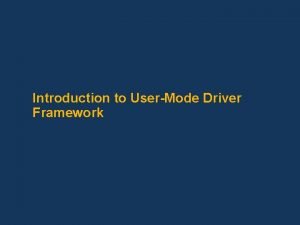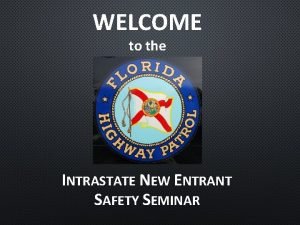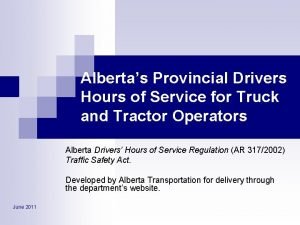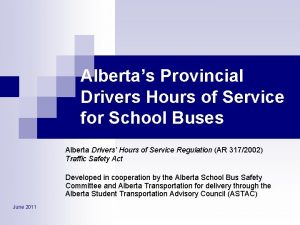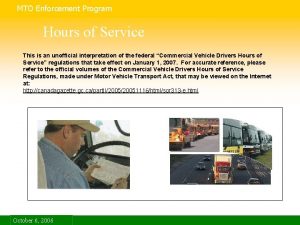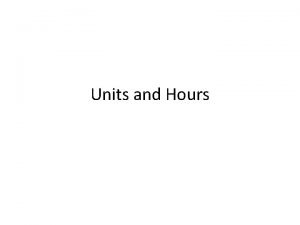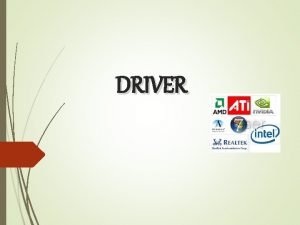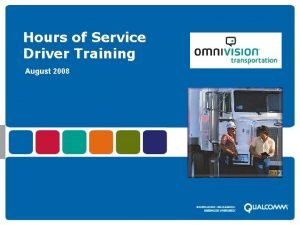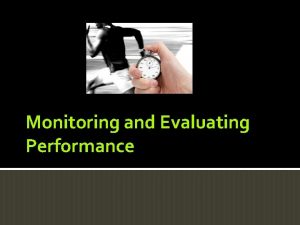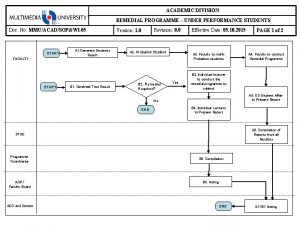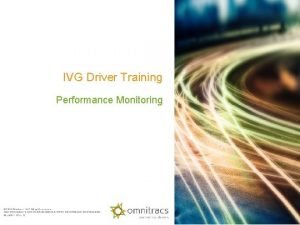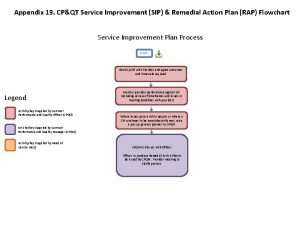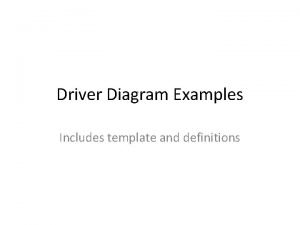Monitoring Driver Performance Hours of Service and Remedial


















- Slides: 18

Monitoring Driver Performance, Hours of Service and Remedial Driver Training Mike Mc. Donal and Jeff Marley Bus Industry Safety Council Mentors

Monitoring Driver Performance What are we monitoring Speed Idling Hard turns and Stops Interaction with passengers Vehicle inspections Hours of service violations

Monitoring Driver Performance How are we measuring this? What thresholds do we use? What is the standard of acceptable behavior ? Are all drivers measured the same? Level playing field for full time versus part time

Monitoring Driver Performance

Monitoring Driver Performance Telematics Is the information easy to find and understand Is the information available to the drivers real time Can drivers challenge the information?

Monitoring Driver Performance How do we handle drivers with poor performance matrix? Coaching Retraining At what point does a disciplinary action possibly take place? What are your company policies for the infractions you are monitoring? Are the policies in writing and kept up to date ?

Monitoring Driver Performance Hours of Service Training is definitely the key for new as well as returning drivers Remember the basics 8, 10, 15, 7/60, 8/70 Be mindful of unassigned movements Check daily for violations Personal conveyance to allow or not allow and the monitoring that goes along with it Remind returning drivers of the HOS changes from last September

Monitoring Driver Performance Short haul exemption 150 air mile radius 14 consecutive hours Still only 10 hours driving Must return to the place of dispatch Adverse Conditions Still unforessen prior to dispatch Extends drive time as well as on duty time for an additional up to 2 hours each to get to a safe place

Training and Retraining Your Drivers Fixed Object Accidents Why Do they Happen? In this session we will discuss some of the most common errors that Coach Operators make resulting in Fixed Object Accidents.

Training and Retraining Your Drivers Mirror Adjustment Setting your mirrors will cut down (but doesn't eliminate) blind areas at the sides, front and back of your coach. The steps for mirror adjustment are very simple: If necessary, move the arm holding each mirror so that you have an unobstructed view of the entire mirror. Rotate both flat mirrors horizontally until the inside edges pick up the rear corners of the coach body. This is just to permit you to see what is happening right next to the coach. Do not rotate them inward too far. Rotate the left flat mirror vertically until the bottom one-third of mirror shows the roadway. That is, the horizon is about one-third of the way from the bottom of the mirror. Left mirror is used to look far behind the coach. Rotate the right flat mirror vertically until the bottom two-thirds of mirror shows the roadway. That is, the Horizon is about one-third of the way from the top of the mirror. Right mirror set low to the ground to check blind spots. You never know what you might miss if you don’t have your mirrors adjusted properly!

Training and Retraining Your Drivers Blind Spots Notice that you have four blind areas: One at the rear of the coach. It is possible that three or four small vehicles (fixed objects) could be in this spot, and you wouldn't be able to see them. One at the right side. Cars (fixed objects) in the right side may not be visible to you, especially close to your door. One at the left side. Cars passing or holding position in the left lane may be hidden from your view. One Immediately in front of your coach. It is possible for a child, adult, and animal or fixed object to be immediately in front of the coach and hidden from view. Convex mirrors can show you areas that the flat mirrors do not cover. They help you see further out to the left and right. And they allow you to see roadway closer to the front of your coach. Because of this, they help to cut down (but they do not eliminate) the left and right blind spots. Never judge distance with convex mirrors. You never know what you may see in your blind spots.

Training and Retraining Your Drivers

Training and Retraining Your Drivers Understanding Your Coach Dimensions As A coach operator you operate many different Makes of Coaches. Its very important to know the Dimensions of the Make and Model coach you are going to operate. Basic Dimensions Height (basic height) 11`2 to 12’ 4 ft. Length ( 40 & 45 ft) Width (102 inc. ) Knowing the dimensions will determine how this particular model coach maneuvers. (Instructor will explain). Damage and injuries Cause by not knowing the Dimensions of your Vehicle Height: The things that cause avoidable damage to coach roofs and sides most often are underpasses, tunnels, canopies, tree limbs, light poles, street signs, etc. . Width: There are few major roads in the US that Coaches are too wide to travel. The lanes of most highways are 12 to 14 feet wide. However, most states have some narrow roads (Us & Farm to Market Roads). Most parking lots are not designed for wide vehicles (coaches). This applies to churches, schools, restaurants, ect. Length: The length of the coach can give the coach operator problems in turns, parking, passing, etc. . Weight: : The weight of your coach is also something you always need to keep in mind. Most coaches weight between 28, 000 to 36, 000 pounds empty. 49, 000 to 53, 000 pounds maximum weight. If you should find yourself on a road, approaching a bridge, and there are signs saying, “Weight Limit 10 Tons, ” you have a weight problem, even if you are empty. Do not drive all the different Make/Models the same. Each Make/Model will maneuver differently. Know the differences of each Make/Model.

Training and Retraining Your Drivers Off Tracking Off-tracking refers to the fact that, when making a turn, the rear wheels of the coach will track inside the front wheels. The longer the vehicle, the greater the off-tracking. Cars also have off-tracking to some degree. But it's so slight in cars that the drivers usually don't have to think about it when making a turn. On the other hand, coach operators typically have to think about off-tracking whenever they are maneuvering the coach. Key point to remember about off-tracking is to think about how to maneuver the front of the coach to make the back of the coach go where you want it to go.

Training and Retraining Your Drivers Pivot Point The Pivot Point is a concept that will help you solve the problem of off-tracking. It's the point around which the rest of your coach turns. It doesn't actually stand still while the rest of your coach moves around it, but it's the point that moves the least. The coach has two pivot points. One on the right, and one on the left. Your pivot point on a 45 ft. three axle coach is between the drive and tag axle. This is the point that the coach has cleared any object and shouldn’t hit it. In making a right turn, if you were to pull straight out into an intersection until the curb of the street you're turning into is even with the pivot point, you can turn the steering wheel all the way to the right and make the turn without hitting anything or pedestrians. If you are making a left turn as you approach the corner, you can start the left turn a little earlier. For example, you might start turning when the center line of the intersecting street is about at the second baggage door.

Training and Retraining Your Drivers Tail Swing Because of the rear overhang, the rear of the coach has a tail swing. A tail swing starts just past the pivot point of the coach and ends at the rear of the bumper. You should be aware that tail swing occurs when you turn the coach, whether the coach is moving forward or backwards. Tail swing happens any time that you maneuver the coach. For example: If you are turning the coach the tail swing will be to the opposite side you are turning. That's why you must watch your mirrors to both side of the coach when making any maneuver.

Training and Retraining Your Drivers Backing Accidents Backing a coach safely is a hard thing to do. Backing is, by far, the most frequent type of coach accident that involves hitting a fixed object. Both the coach and the fixed object are often heavily damaged. Backing accidents frequently involve pedestrians who are injured because they have walked into the blind spot behind the coach. Guidelines For Backing Ask yourself… Is it really necessary? Back to the driver's side. Back into, not out of. Use both mirrors. Get out and look over the area before backing if its safe to do so (repeat if necessary). Use a guide. Back slowly. Tap your horn. Use emergency flashers when backing. It’s the responsibility of the coach operator not to hit any fixed objects or pedestrians when backing. Think Safety Always.

WE ARE HERE TO HELP !! Jeff Marley Lancer Insurance Jmarley@lancerinsurance. com 516 -519 -4807 Mike Mc. Donal Saucon Technologies mmcdonal@saucontech. com 410 -245 -5525 ABA SAFETY AND MAINTENANCE COUNCIL MENTOR PROGRAM
 Service fabric performance monitoring
Service fabric performance monitoring User mode driver framework
User mode driver framework Dot and hours of service rules
Dot and hours of service rules Florida intrastate hours of service rules
Florida intrastate hours of service rules Hours of service examples
Hours of service examples Alberta provincial logbook rules
Alberta provincial logbook rules Split sleeper berth canada
Split sleeper berth canada Stopelog
Stopelog Provincial hours of service
Provincial hours of service Hours of service mto
Hours of service mto Monitoring and coaching form for teachers
Monitoring and coaching form for teachers Aix weather widget
Aix weather widget Moodle
Moodle Vessel performance monitoring system
Vessel performance monitoring system Siebel server monitoring
Siebel server monitoring Cho hwc performance monitoring system
Cho hwc performance monitoring system Cisco ucs monitoring tools
Cisco ucs monitoring tools Pv performance monitoring
Pv performance monitoring Control loop performance monitoring
Control loop performance monitoring

